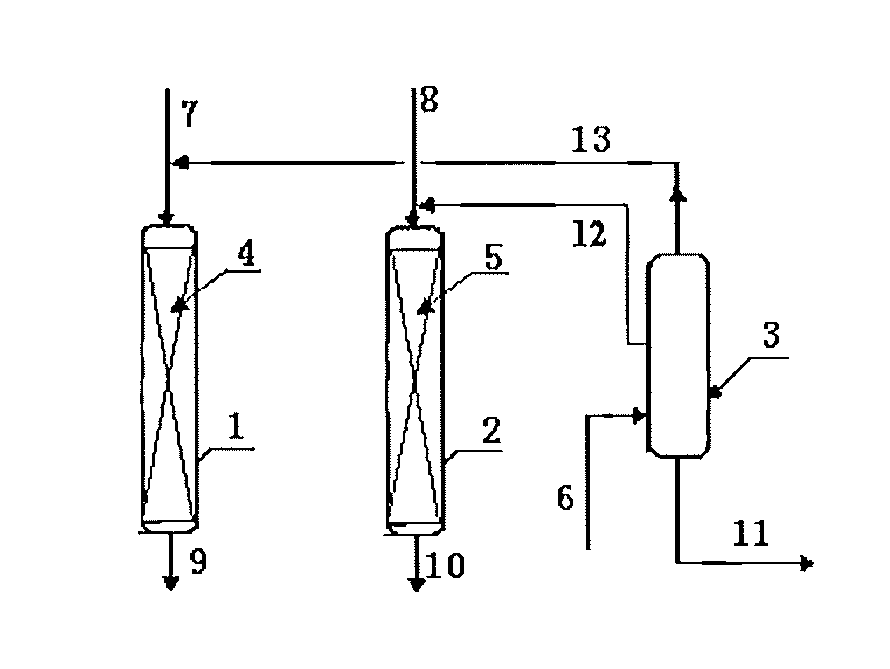Process for producing cumene
- Summary
- Abstract
- Description
- Claims
- Application Information
AI Technical Summary
Benefits of technology
Problems solved by technology
Method used
Image
Examples
example
Example 1
[0033]According to the procedures of FIG. 2, the first transalkylation reactor was loaded with 20 g of a catalyst of Beta zeolite, and the second transalkylation reactor was loaded with 50 g of a catalyst of MCM-22 zeolite. The reaction conditions of the first transalkylation reactor comprised: a reaction temperature of 150 degrees C., a reaction pressure of 1.2 MPa, a flow rate of the first benzene stream (stream 7) of 40 g / hr, a feeding rate of the polyisopropyl benzene (stream 13) of 20 g / hr, and a content of diisopropylbenzene in stream 13 of 98%. The reaction conditions of the second transalkylation reactor comprised: a reaction temperature of 180 degrees C., a reaction pressure of 1.5 MPa, a flow rate of the second benzene stream (stream 8) of 80 g / hr, a flow rate of the polyisopropyl benzene (stream 12) of 80 g / hr, and a content of tri-isopropylbenzene in stream 12 of 10%. The reaction was carried out continuously for 5 days.
[0034]The operation conditions of the poly...
example 2
[0036]According to the procedures of FIG. 2, the first transalkylation reactor was loaded with 30 g of a catalyst of Beta zeolite, and the second transalkylation reactor was loaded with 40 g of a catalyst of MCM-22 zeolite. The reaction conditions of the first transalkylation reactor comprised: a reaction temperature of 143 degrees C., a reaction pressure of 1.2 MPa, a flow rate of the first benzene stream (stream 7) of 60 g / hr, a feeding rate of the polyisopropyl benzene (stream 13) of 20 g / hr, and a content of diisopropylbenzene in stream 13 of 99%. The reaction conditions of the second transalkylation reactor comprised: a reaction temperature of 175 degrees C., a reaction pressure of 1.5 MPa, a flow rate of the second benzene stream (stream 8) of 60 g / hr, a flow rate of the polyisopropyl benzene (stream 12) of 40 g / hr, and a content of tri-isopropylbenzene in stream 12 of 8%. The reaction was carried out continuously for 5 days.
[0037]The operation conditions of the polyisopropyl ...
example 3
[0039]According to the procedures of FIG. 2, the first transalkylation reactor was loaded with 50 g of a catalyst of Beta zeolite, and the second transalkylation reactor was loaded with 40 g of a catalyst of SHY-1 zeolite. The reaction conditions of the first transalkylation reactor comprised: a reaction temperature of 150 degrees C., a reaction pressure of 1.2 MPa, a flow rate of the first benzene stream (stream 7) of 100 g / hr, a feeding rate of the polyisopropyl benzene (stream 13) of 60 g / hr, and a content of diisopropylbenzene in stream 13 of 98%. The reaction conditions of the second transalkylation reactor comprised: a reaction temperature of 180 degrees C., a reaction pressure of 1.5 MPa, a flow rate of the second benzene stream (stream 8) of 80 g / hr, a flow rate of the polyisopropyl benzene (stream 12) of 80 g / hr, and a content of tri-isopropylbenzene in stream 12 of 5%. The reaction was carried out continuously for 5 days.
[0040]The operation conditions of the polyisopropyl ...
PUM
| Property | Measurement | Unit |
|---|---|---|
| Pressure | aaaaa | aaaaa |
| Pressure | aaaaa | aaaaa |
| Frequency | aaaaa | aaaaa |
Abstract
Description
Claims
Application Information
 Login to View More
Login to View More - R&D
- Intellectual Property
- Life Sciences
- Materials
- Tech Scout
- Unparalleled Data Quality
- Higher Quality Content
- 60% Fewer Hallucinations
Browse by: Latest US Patents, China's latest patents, Technical Efficacy Thesaurus, Application Domain, Technology Topic, Popular Technical Reports.
© 2025 PatSnap. All rights reserved.Legal|Privacy policy|Modern Slavery Act Transparency Statement|Sitemap|About US| Contact US: help@patsnap.com


